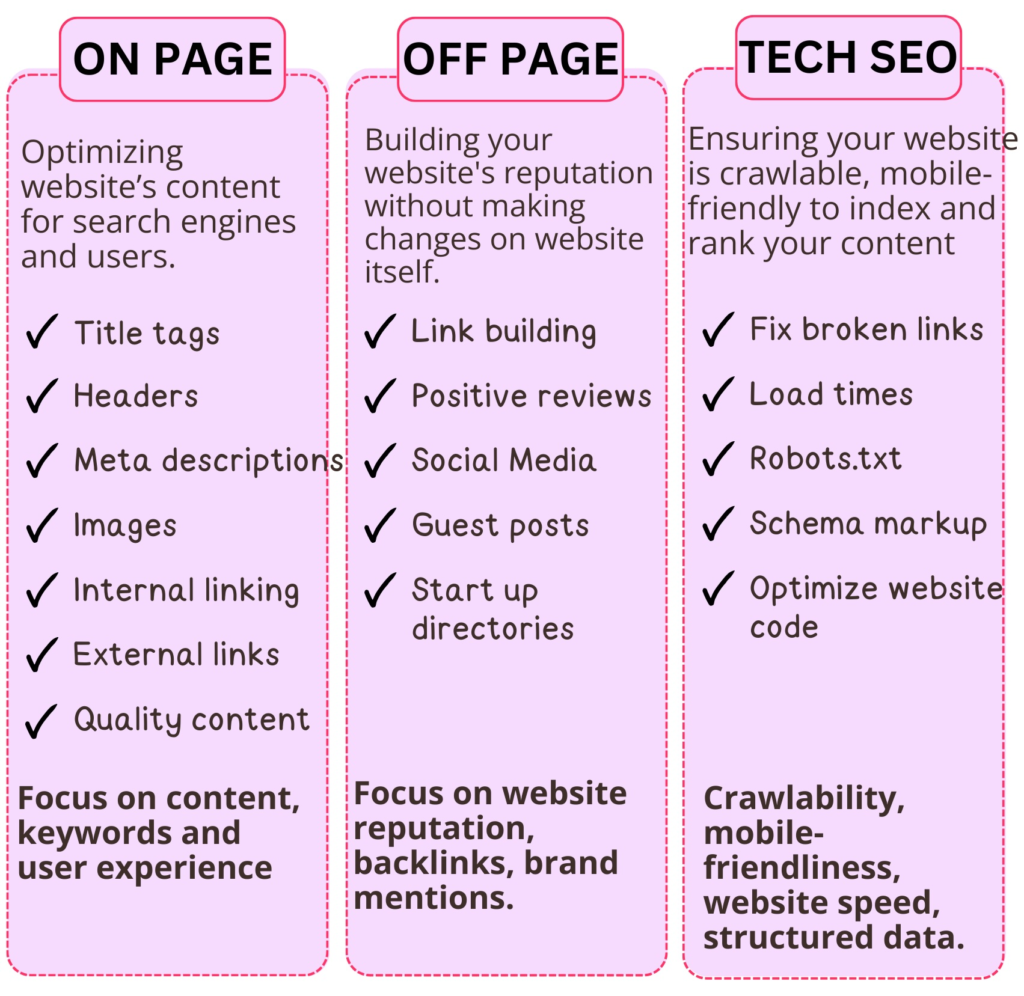Guide To Cracking SEO Ranking
Recently I get asked a lot SEO questions by founders and business owners. The range of questions I get include:
→ Are there tricks to doing SEO correctly?
→ Are there basic foundational steps all of us should follow?
→ Are there ways to rank without spending money?
→ How do we do SEO right without hiring people?
To answer these questions, I am compiling years of my experience into this massive resource with downloadable templates, checklists, cheatsheets. It’s the exact process I am using at Rava.ai as well.
This week alone I have helped 3 different companies on setting up an SEO process to get ranked on google and generate traffic and revenue. Here are the few things I walked them through and topics am covering in this article:
→ How to laser-focus on customers
→ Performing in-depth keyword research
→ Copywriting techniques (with examples)
→ On-page SEO & UX best practices
→ Technical optimization
Getting Started with SEO
Understanding search engine algorithms
- Search engine algorithms are sets of rules that determine which websites appear in search results and in what order. The aspects considered to determine this are:
- Relevance: Does your website answer the user’s search query?
- Content quality: Is your content informative, well-written, and engaging?
- User experience: Is your website easy to navigate and mobile-friendly?
- Backlinks: Do other reputable websites link to yours?
- Take away: Ensure that the content you are writing is relevant, high quality and sharable. Make sure your website is accessible on mobile, tablet and desktop and is responsive.
Understanding where you stand
Here are several ways to understand where your website stands with SEO:
1. SEO Audit:
Several free and paid SEO audit tools can analyze your website and provide insights into various aspects of your SEO performance. These tools typically crawl your website, identify technical issues, analyze on-page optimization elements, and offer suggestions for improvement. Popular options include:
- Free tools: SEOptimer , Google Search Console, Uber Suggest, SEO Analyzer
- Paid tools: Moz Pro, Ahrefs, SEMrush
2. Analyze Domain Authority and Page Authority:
While not the sole indicators of SEO success, Domain Authority (DA) and Page Authority (PA) scores can provide a general sense of your website’s relative strength and ranking potential compared to other websites.
- Tools: Moz bar browser extension, Ahrefs website authority checker, Ahrefs backlink checker, SEMrush Free SEO audit, Uber suggest research and site audit
3. Track Your Website Traffic and Rankings:
Monitoring your website traffic and keyword rankings over time can help you gauge the effectiveness of your SEO efforts. Tools like Google Analytics and Search Console provide valuable data on website traffic sources, keyword rankings, and user behavior. By analyzing these metrics, you can identify areas for improvement and track your progress towards your SEO goals.
Tools: Pagespeed Insights, GTMetrix, Google Analytics, Similarweb webtraffic estimator
SEO Basics for your site:
1. Robots.txt:
- Purpose: Controls which pages search engine crawlers can access and index.
- Importance: Helps prevent indexing of private or irrelevant content, improving crawl efficiency.
- How to ensure:
- Create a text file named
robots.txtin your website’s root directory. - Use directives like
Disallowto block specific URLs or directories. - Allow search engine crawlers to access essential files like sitemap and CSS.
- Use online tools or consult documentation for proper syntax.
- Create a text file named
- Tip: Check out https://rava.ai/robots.txt for how this is implemented. You can do a free website crawl test on Seomator.
2. Sitemap:
- Purpose: Informs search engines about the structure and pages of your website.
- Importance: Improves search engine understanding of your website, potentially leading to better indexing and ranking.
- How to ensure:
- Generate an XML sitemap listing all important pages of your website.
- Use online tools or plugins to easily generate and update your sitemap.
- Submit your sitemap to search engines like Google Search Console.
- Tip: A simple hack to view a list of indexed pages for your website, is simply go to google and type: site:yourwebsite.com. If you want to see if a particular keyword is appearing within your site, you can also try site:yourwebsite.com keyword (ensure no space between colon and your URL). You can also check all your indexed pages across videos, images etc by clicking on the google search result categories. You can use the same command across browsers to see what each of the search engines are indexing for your website.
3. Schema.org markup:
- Purpose: Provides search engines with additional information about your website content, enhancing search results.
- Importance: Can lead to richer search snippets, potentially improving click-through rates.
- How to ensure:
- Implement relevant schema markup (e.g., product schema for e-commerce websites) using structured data formats like JSON-LD or Microdata.
- Use online tools or plugins to simplify schema implementation.
- Test your schema markup using tools like Google Search Console’s Rich Results Test and Schema validator.
- You can also use our free schema generator here.
3 Tenets Of SEO

Technical SEO
The goal of Tech SEO is to ensure mobile friendliness, website speed and performance and ensuring structure and site architecture of data so search engines are able to find, understand and crawl the website. Things to consider for Tech SEO include are:
- Image Optimization:
- Compress images using tools like TinyPNG or Smush.
- Use descriptive filenames and alt text for images.
- Page Speed Optimization:
- Identify speed issues with Google PageSpeed Insights or Pingdom.
- Fix critical errors like large images, render-blocking JavaScript, and leverage browser caching.
- Mobile-friendliness:
- Ensure proper mobile rendering using Google Mobile-Friendly Test.
- Address any identified mobile responsiveness issues.
- Indexing and Crawlability:
- Check Google Search Console Coverage report for indexing errors.
- Use Screaming Frog for deeper crawl analysis and identify potential issues.
- Broken Link Checking:
- Scan for broken links using DrLinkCheck or Dead Link Checker.
- Redirect or remove broken links.
- Website Security:
- Implement HTTPS encryption with free SSL certificates from Let’s Encrypt.
- Robots.txt and Sitemap:
- Create and submit a robots.txt file to control search engine crawling.
- Create and submit an XML sitemap listing all important website pages.
- Structured Data Markup:
- Implement relevant schema markup (e.g., product schema) using JSON-LD or Microdata.
- Test schema markup for errors using Google Search Console Rich Results Test.
- Server Response Time:
- Monitor server response time with Pingdom or GTmetrix.
- Contact your hosting provider if consistently slow.
- Internal Linking:
- Link relevant pages internally using descriptive anchor text.
- Log File Analysis:
- Analyze server logs to identify crawl errors, security threats, and user behavior patterns.
- Consider AMP Implementation (Optional):
- Implement AMP for faster mobile loading, especially for news or content-heavy websites.
If you are looking for a checklist to make all of these happen, you can download it at the end of this article.
On-Page Optimization
For On Page SEO, consider the following:
- On-Page SEO Bullet Points:
- Target relevant keywords: Research and incorporate keywords naturally throughout your content.
- Structure content logically: Use clear headings, subheadings, and bullet points for easy navigation.
- Optimize images: Compress file size, use descriptive filenames, and write informative alt text.
- Craft compelling titles and meta descriptions: Keep titles under 60 characters and meta descriptions under 160 characters, both including your target keyword and enticing users to click.
- Strategically link internally and externally: Link to relevant internal pages and high-authority external sources using descriptive anchor text.
- Format for readability: Use short paragraphs, bullet points, and visuals to break up text.
- Ensure mobile-friendliness and fast loading speed: Make sure your website displays well and loads quickly on all devices.
- Implement schema markup: Provide search engines with additional information about your content.
- Regularly update content: Keep your content fresh and relevant to maintain user engagement and search engine interest.
- Include a clear call to action (CTA): Guide users towards your desired action, like subscribing, purchasing, or contacting you.
If you are looking for a checklist to make all of these happen, you can download it at the end of this article.
Off-Page Optimization
For Off Page SEO, consider the following:
- Earn natural links: Create high-quality content and build a positive brand reputation.
- Conduct backlink outreach: Contact relevant websites and request backlinks to your content.
- Build broken links: Find broken links on relevant sites and suggest your content as a replacement.
- Guest post on high-authority websites: Contribute valuable content with backlinks to your site.
- Submit your website to relevant directories: Increase visibility in niche-specific listings.
- Encourage social media sharing: Share your content and engage with your audience.
- Build relationships with bloggers and influencers: Collaborate on content creation or other opportunities.
- Engage in PR and media outreach: Generate positive brand mentions and potential backlinks.
- Manage online reviews and reputation: Encourage positive reviews and address negative ones professionally.
- Optimize for local SEO (if applicable): Improve visibility for local searches.
- Track your brand mentions using tools such as Followerwonk
If you are looking for a checklist to make all of these happen, you can download it at the end of this article.
SEO Optimized Content
Keyword Research and Analysis
- Customer Research:
- Analyze customer data (transcripts, recordings, interviews) to understand ICP hopes, fears, and dreams.
- Conduct social listening on relevant platforms to discover their problems and aspirations.
- Content Topic Selection:
- Prioritize topics based on user intent, starting with MOFU and BOFU content.
- Competitor Keyword Analysis:
- Use Ahrefs (free trial) to identify competitor high-traffic keywords.
- Analyze competitor content for gaps and low-hanging fruit opportunities.
- Keyword Research:
- Use Semrush (free trial) and ChatGPT to discover relevant keywords.
- Utilize Google suggestions, related searches, and ask ChatGPT for specific user questions.
- Validate search volume and difficulty using Google Keyword Planner.
- Content Planning:
- Analyze top-ranking SERP content for format, length, and comprehensiveness.
- Develop a detailed content outline with target audience, format, topic, sub-topics, angle, and tone.
- Include visuals and plan to win featured snippets by addressing the potential question directly.
- Create content that is bigger, better, and different, offering unique value and addressing user needs.
Content Marketing
The key elements for crafting compelling and search-engine-friendly content are:
- Craft an attention-grabbing intro with a hook: Hook should be the first line that captures user attention.
- Ensure expertise for highly technical/niche topics: Involve experts or enthusiasts as contributors.
- Support claims with evidence & data: Include research, statistics, stories, case studies, and concrete examples.
- Maintain clarity & visualization: Use clear language, avoid jargon, and show concepts through examples and visuals.
- Offer unique value & depth: Go beyond the obvious, provide actionable advice, and address user needs comprehensively.
- Over-deliver on content: Include more details, examples, and resources than expected.
- Leverage industry credibility: Feature quotes/contributions from relevant influencers.
- Enhance readability & conciseness: Aim for a 9th-grade reading level, avoid passive voice, and utilize transition words effectively.
- Engage readers with active voice & specific words: Use punchy verbs, be specific, and adopt a conversational style.
- Organize content for flow & navigation: Use clear headings (H1-H4), mini-headlines, and a table of contents for lengthy pieces.
- Boost visual appeal: Include relevant images, screenshots, tables, and infographics.
- Improve readability with content chunking & summaries: Break down large content and summarize key findings for dense pieces.
- Target relevant keywords: Include the target keyword in the first 100 words, headings, and naturally throughout the content (avoid keyword stuffing).
- Build authority with external linking: Link to high-authority websites (.edu, research institutions) relevant to your topic.
- Optimize for search engines:
- Use your target keyword in the first 100 words.
- Wrap your keyword and variations in headings (H1, H2, H3, H4).
- Use your target keyword in H1.
- Use LSIGraph tools to find related keywords.
- Sprinkle your keyword and variations naturally.
- Optimize your URL for SEO (short & keyword-rich).
- Integrate a compelling featured image.
- Content based on funnel stage:
- TOFU/MOFU (Educate): Include a “pitch-free about us” section.
- MOFU/BOFU (Solve problems): Include a “try our product/service” section.
- All stages: Create downloadable resources to collect email addresses.
- Craft compelling title tags & meta descriptions:
- Title tag: Include target keyword, 60 characters max, use creative twists.
- Meta description: Include target keyword, 160 characters max, highlight takeaways and a call to action.
- Additional elements:
- Include internal links to relevant website pages.
- Add content sections (About Us, About Our Product, etc.).
- Include a clear call to action (CTA).
Analytics
Unless you are continuously monitoring and optimizing for SEO, there would be no big gains. Also remember that SEO takes time so its important to keep monitoring and keep writing content.
- Track keyword performance: Monitor organic traffic and rankings to identify high-performing and underperforming keywords (Google Search Console, Google Analytics).
- Analyze user behavior: Use bounce rates and session duration to identify pages with low engagement and improve content, navigation, and user experience (Google Analytics).
- Discover top landing pages: Understand what content resonates with users and attracts traffic to inform future content creation (Google Analytics).
- Monitor backlinks: Track your website’s backlink profile to identify opportunities for link building and improve website authority (Google Search Console).
- Segment your data: Analyze website traffic and user behavior by various criteria to understand how different user groups interact with your website and tailor your SEO strategy accordingly (Google Analytics).
- Set up conversion tracking: Measure the effectiveness of your SEO efforts in driving desired actions like purchases, signups, or downloads (Google Analytics).
- Regularly monitor and analyze data: Stay updated on website performance trends and identify areas for improvement.
- Combine analytics with other SEO tools: Utilize keyword research, competitor analysis, and on-page optimization tools alongside analytics data for a comprehensive approach.
At minimum, you should track the following metrics:
| Website Visitors | Total number of users visiting your website |
| Unique Visitors | Number of individual visitors to your website |
| New vs. Returning Visitors | Breakdown of new and returning website visitors |
| Average Time on Website | Average time users spend on your website |
| Average Session Duration | Average length of a user’s visit (including multiple page views) |
| Page Views | Total number of times individual pages are loaded |
| Most Visited & Least Visited Pages | Pages with the highest and lowest number of views |
| Bounce Rate | Percentage of visitors who leave after viewing only one page |
| Bounce Rate by Page | Bounce rate for each individual page |
| Pages with Highest & Lowest Bounce Rates | Identify pages with the best and worst user engagement |
| Pages per Session | Average number of pages viewed per visit |
| Organic Traffic | Website traffic originating from search engines |
| Organic Keyword Rankings | Position of your website in search engine results pages (SERPs) for specific keywords |
| Top Landing Pages | Pages that users land on from search engine results |
| Backlinks | Number of links from other websites pointing to your website |
| Referring Domains | Unique websites linking to your website |
| Conversions | Completion of desired actions on your website (e.g., purchases, signups) |
In addition to the above, here are few more tips around social media, local SEO and content:
Social Media Marketing
- Active Presence: Regularly share engaging content on relevant platforms and interact with your audience.
- Community Building: Join and participate in online communities related to your niche.
- Social Sharing: Encourage your audience to share your content on social media.
- Social Media Ads: Utilize targeted ads to reach a wider audience on social platforms.
Content Marketing
- Create High-Quality Content: Publish informative, engaging, and valuable content that resonates with your target audience.
- Content Variety: Diversify your content formats (articles, infographics, videos, etc.) to appeal to different preferences.
- Content Promotion: Promote your content through social media, email marketing, and guest blogging.
- Thought Leadership: Establish yourself as an expert in your field by contributing to industry publications and forums.
Local SEO
- Claim and Optimize Google My Business: Optimize your listing with accurate information, photos, and customer reviews.
- Local Citations: Build citations on relevant directories and local business listings.
- Community Engagement: Participate in local events and online communities to increase visibility.
- Positive Reviews: Encourage satisfied customers to leave positive reviews on online platforms.
Additional Resources:
Here is also a downloadable guide that shows you all the steps to implement, tools to use and actions to take to generate more traffic.
Please do share this article if you think others will find it helpful.






